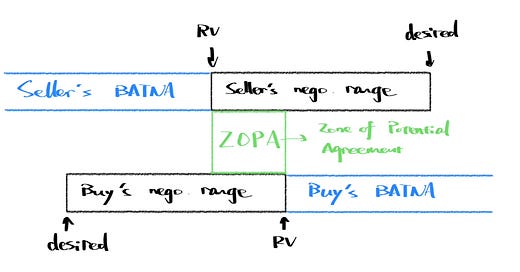[Book Club] Negotiation Genius
Negotiation Genius: How to Overcome Obstacles and Achieve Brilliant Results at the Bargaining Table and Beyond
Deepak Malhotra
Three-Sentence Summary
A very detailed guide on negotiations, especially business contract-related topics. It completes the picture with facts and studies from psychology and behavioral economics, even though there are books specifically on those topics. The value creation part is an eye-opener for me.
Who Is This Book For?
Someone who believes people should be rational during negotiations. Someone who looks for more practical tactics than Getting to Yes. Someone who is generally interested in negotiations and has minimal experience.
Major Concepts
One and a half years ago, over three months, I participated in a series of negotiations. I was aware that these were serious professional meetings where deals got settled, including budgets, resources, timelines, relationships, etc. However, what I missed was that I didn’t clearly treat them as negotiations. This means I didn’t apply any negotiation tools properly if I had applied them in the first place. Now, looking back, I believe I could do better.
Like always, complex topics typically have systematic ways to approach them. I highly recommend reading this book back to back. Every page is worth the attention. I will only summarize the part that I find most informative. Otherwise, it will be a copy of the entire book.
You can never exaggerate on emphasize preparation.
There are five concrete things to prepare before the negotiation, regardless of whether you are the buyer or seller:
Your BATNA (Best Alternative To Negotiated Agreement.) BATNA is not what you think is fair, what you originally paid for the item you are selling or the price you hope to achieve. Your BATNA is the reality you will face if you reach no deal in the current negotiation.
Your RV (Reservation Value.) This is the break-even point where you are indifferent between accepting the current offer or selecting your BATNA.
The other party’s BATNA.
The other party’s RV.
ZOPA (Zone Of Possible Agreement.)
The figure above shows the five concepts. It means if there is no overlap between the two party’s negotiation range, the deal will not be possible to make. At least in the normal sense.
This sounds too simple! The reality is that it is difficult to find out the other party’s negotiation range. Sometimes, it is also complicated to figure out any concrete numbers for those five. Of course, we have systematic approaches for that too.
It is all about information gathering.
You should never stop gathering information, even after the negotiation. Here is a checklist that might help.
Before the negotiations:
Identify all plausible alternative options. Estimate the value associated with each alternative. Select the best one, and this is the BATNA.
Identify your interests. Multiple interests. It can be simple to have only one interest, but the negotiation can hit wall quite quickly.
Create a scoring system for all interests.
Calculate a package RV using the scoring system.
Identify your assumptions (especially about the other party.)
During the negotiations:
Ask questions that challenge your assumptions. Lots of times, you think you know is not what it is.
Don’t make the first offer when you don’t have much information. Defer an opening offer and collect information through direction or indirect questions. Or let the other party make the first offer.
If the other party’s offer is aggressive. Try to shift the conversation to an entirely different topic, as they are setting an anchor to bend your reality.
Focus on information rather than influence. Information is what they believe, and they want; influence only tries to derail your strategy.
Don’t just ask what (the offer is about); also ask why (the offer is that).
After the negotiations:
Evaluate the negotiation result. You should focus on your target value during the negotiation; when it is over, shift your focus to your RV.
Don’t let negotiations end with a rejection of your offer. Instead, they should either end with a “yes” or with an explanation as to “why not.”
If there is a new piece of information coming. Don’t be afraid to make a post-settlement settlement (PSS) as long as it brings than diminishes value.
Creating values rather than settling demands.
There is a pair of brilliant concepts in creating values.
Pareto improvement: changes to a deal that makes at least one person better off without making anyone worse off.
Pareto efficient: until there is no way to make one party better off without hurting the other.
There are many ways to create values, and all of them should bring a Pareto Improvement. The final contract ideally should be at Pareto Efficient. As said, packing more and more interests, issues or items inside an offer means more things two parties can give or take. That leads to more value.
Imaging a contract as a multi-dimensional function. It is multi-dimensional because the world involves people, which is very complicated. To find the global minimum of this function, we need to tune as many control points as possible. In this case, the control points are the interests. You might only find the local minimum if you only have a few of them. The more points to tune, the closer to the global minimum. In other words, the more interest there is in the negotiation table, the closer the contract will be to Pareto Efficient.




